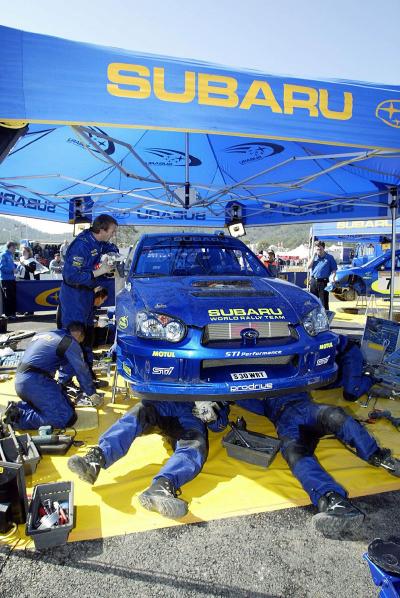Technical talk - Service data analysis.
With the majority of WRC service halts limited to just 20 minutes, WRC engineers face a real challenge to apportion the time effectively.
To begin with there's routine work, like tyre changes, damper settings and suspension checks to be carried out, and then any unplanned work like repairs to mechanical components or bodywork. Planning the work is crucial, and begins a lot sooner than when the car drives into the service area, as 555 Subaru team principal engineer Pierre Genon explains...
With the majority of WRC service halts limited to just 20 minutes, WRC engineers face a real challenge to apportion the time effectively.
To begin with there's routine work, like tyre changes, damper settings and suspension checks to be carried out, and then any unplanned work like repairs to mechanical components or bodywork. Planning the work is crucial, and begins a lot sooner than when the car drives into the service area, as 555 Subaru team principal engineer Pierre Genon explains...
"The first time we get to see the car and carry out a visual inspection is at the holding area just before the service-in control. The crews tend to arrive here ahead of schedule, which gives us a chance to look over the car and talk to the driver. I'll go the control with some of the senior technicians to agree a job-list for the service. We're able to get as close as we like to the car, but not to touch it. At the control we find out how the driver got on, and discuss any changes they'd like to make.
"At this time we also download electronic data from the car, which is collected during the stages. This data is used for two purposes, one is to help analyse the performance of the driver, while the other is to check the health of all the car's systems. In simple terms, the car can tell us how well it's working. The data is taken straight to the engineering office in the service area for analysis before the car arrives.
"The first thing our engineers do when they get the data is study it using software that displays it graphically on a laptop computer. The human eye is still the quickest way of scanning to see if everything is behaving itself and for an experienced engineer, it's very easy to look at, for example, a graph of diff pressures through the stages and see if it looks normal. Our engineers will study the data collected from three key areas, the engine, transmission and chassis to check that there are no faults and that everything is running properly. On the engine we monitor things like oil pressure, temperatures, boost pressure, turbo speed, while on the transmission we monitor the temperature and fluid pressures in the system, as well as pressures in the electronic differentials. Among our chassis information, we have data on things such as the steering wheel and pedal positions.
"On a test we record a huge amount of information, measuring all sorts of things about how the car is moving to give the engineers data for improving the car. But on a rally it's much more about maintaining the condition of the car. We study the data to try and anticipate any problems. By identifying and monitoring any trends, we try to stay ahead of any technical problems that may be developing.
"It's a good system and it really helps when the timing is tight. By the time the car arrives with us in service, we've already been able to analyse the condition of most of the major mechanical components from the data alone."


![Johann Zarco, LCR, Honda RC213V, 2024 San Marino MotoGP, Misano, action [Gold & Goose]](https://cdn.crash.net/styles/thumbnail/s3/2024-09/GnG_1166323_HiRes.jpg?itok=vpgrU7Q4)

![Jack Miller, KTM Factory Racing, KTM RC16, San Marino MotoGP, Misano, action [Gold & Goose]](https://cdn.crash.net/styles/thumbnail/s3/2024-09/GnG_1167624_HiRes.jpg?itok=iz7mA4EQ)


![Fabio Quartararo, Monster Energy Yamaha Racing, Yamaha M1, 2024 MotoGP, Misano Test, action [Gold & Goose]](https://cdn.crash.net/styles/thumbnail/s3/2024-09/GnG_1168928_HiRes.jpg?itok=fcYSole_)
![Toprak Razgatlioglu, ROKiT BMW Motorrad, BMW M 1000 RR, Magny-Cours, WorldSBK [Gold & Goose]](https://cdn.crash.net/styles/thumbnail/s3/2024-09/GnG_1165133_HiRes.jpg?itok=GD5SVNVG)

